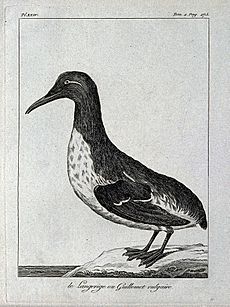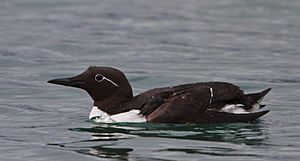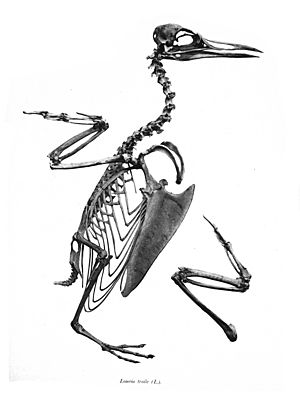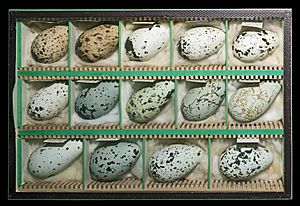Common murre facts for kids
Quick facts for kids Common guillemot |
|
|---|---|
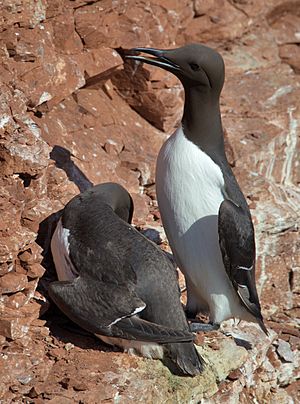 |
|
| Conservation status | |
| Scientific classification | |
| Genus: |
Uria
|
| Species: |
aalge
|
 |
|
| Synonyms | |
|
|
The common murre or common guillemot (Uria aalge) is a large auk. It is also called the thin-billed murre in North America. These birds live in cold waters around the North Atlantic and North Pacific. They spend most of their lives at sea. They only come to land to lay their eggs and raise their young. They prefer rocky cliffs or islands for breeding.
Common murres fly fast and straight. However, they are not very agile in the air. They are much better at moving underwater. They usually dive to depths of 30 to 60 meters (100–200 ft). Some have even been seen diving as deep as 180 meters (600 ft)!
Common murres breed in huge groups called colonies. They nest very close to each other, sometimes touching their neighbors. They do not build a nest. Instead, they lay a single egg on a bare rock ledge on a cliff. The egg hatches after about 30 days. The chick is born with soft, fluffy feathers. It can control its body temperature after 10 days. About 20 days after hatching, the chick leaves the nest ledge. It glides down to the sea, fluttering its wings. The male parent goes with it. The chicks can dive as soon as they hit the water. The female stays at the nest site for about 14 days after the chick leaves.
Both male and female common murres lose their flight feathers after breeding. This means they cannot fly for 1 to 2 months. Some birds return to their nest sites during the winter. Adult birds fly less in winter. They can also find food at night.
Contents
About the Common Murre
Auks are a family of seabirds. They are related to gulls and terns. The common murre belongs to the Uria group. This group also includes the thick-billed murre. These birds are part of a larger group that includes the razorbill, little auk, and the extinct great auk. Scientists figured this out by studying how the birds look and how they live.
The name "guillemot" comes from the French word guillemot. This probably came from the name "William". The name "murre" might come from the sound the bird makes.
What Does a Common Murre Look Like?
The common murre is about 38 to 46 centimeters (15–18 inches) long. Its wingspan is about 61 to 73 centimeters (24–29 inches). Males and females look the same. Their weight changes depending on where they live. Birds in the south weigh about 945 grams (2.1 pounds). Birds in the north can weigh up to 1044 grams (2.3 pounds). Some have been reported to weigh between 775 and 1250 grams (1.7–2.8 pounds).
When they are breeding, their head, back, and wings are black. Their belly is white. They have a thin, dark, pointed beak and a small, dark, rounded tail. After they lose their feathers, their face becomes white. They have a dark line behind their eye. Some common murres in southern Britain are dark brown instead of black. Their legs are grey and their beak is dark grey. Sometimes, adults have yellow or grey legs. In 2008, a rare adult was seen with a bright yellow beak!
Young birds in their first winter look like adults in winter.
Some common murres in the North Atlantic have a white ring around their eye. This white ring extends back as a white line. These are called "bridled guillemots." They are not a different type of murre. It's just a common variation that appears more often in birds that breed farther north. This white marking might help birds recognize each other in crowded breeding colonies.
Chicks are born with soft, fluffy feathers. They are dark on top and white underneath. By 12 days old, most of their body feathers have grown. At 15 days, their face feathers show a dark line across their eye. This line stands out against their white throat and cheek.
How They Fly
The common murre flies with fast wing beats. It can reach speeds of 80 kilometers per hour (50 mph). Groups of murres often fly in a line just above the sea. Because their wings are small for their body size, they are not very agile. Taking off from the water can be hard for them. Common murres cannot fly for 45 to 60 days when they are replacing their main flight feathers.
How They Dive
The common murre is a diving bird. It hunts for food by swimming underwater. It uses its wings to push itself through the water. Dives usually last less than one minute. However, the birds often swim underwater for more than 30 meters (100 ft). They have been recorded diving up to 180 meters (600 ft) deep. They can stay underwater for a couple of minutes.
Where Common Murres Live
Common murres breed on islands, rocky shores, cliffs, and sea stacks. Cape Meares, Oregon has one of the largest colonies of common murres in North America.
| Type | Where they live | What they look like |
|---|---|---|
| Uria aalge aalge | Eastern Canada, Greenland, Iceland, northern Ireland and Britain, southern Norway. | |
| U. a. albionis | Southern Ireland and Britain, France, Germany, Spain, Portugal. | Smaller than the aalge type, with chocolate brown upper parts. |
| U. a. hyperborea | Northern Norway, Northwest Russia, Barents Sea. | Larger than the aalge type, with black upper parts. |
| U. a. intermedia | Baltic Sea. | Looks like a mix between U. a. aalge and U. a. albionis. |
| U. a. spiloptera | Faroe Islands. | |
| U. a. inornata | North Pacific, Japan, Eastern Russia, Alaska. | The largest type of common murre and the largest auk. |
| U. a. californica | California, Oregon, Washington, British Columbia. |
Some common murres stay in one place all year. Birds from the north fly south for the winter. They go to open waters near New England, southern California, Japan, Korea, and the western Mediterranean. Common murres rest on the water in winter.
There are many common murres in the world. Perhaps 7.3 million pairs breed, or 18 million individual birds. Their numbers were stable for a while. But in 2016, many birds died in the northeast Pacific. They seemed very thin and hungry. Scientists are still trying to find out why this happened. Other dangers include too much hunting (which is allowed in Newfoundland), pollution, and oil spills.
Life and Habits
What Common Murres Eat
Common murres can travel far from their breeding places to find food. They often fly 100 kilometers (60 miles) or more. But if there is enough food nearby, they travel much shorter distances. Common murres mainly eat small schooling fish. These fish are usually 20 centimeters (8 inches) long or less. Some of their favorite foods are capelin and sand lances. They also eat polar cod, sprats, Atlantic cod, and Atlantic herring. What they eat most depends on what fish are available. They also eat some molluscs, marine worms, squid, and crustaceans. On average, they eat 20 to 32 grams (0.7–1.1 oz) of food each day. You can often see them carrying a fish in their beak, with the tail hanging out.
Sometimes, they eat snake pipefish. But these fish are not very nutritious. The number of snake pipefish in their diet has been growing. This is because snake pipefish numbers have increased in the North-east Atlantic and North Sea since 2003. At the same time, sandeel numbers have gone down.
How They Communicate
Common murres make different sounds. One sound they make is a soft purring noise.
How They Reproduce
Common Murre Colonies

Common murres nest in very crowded colonies. These are sometimes called "loomeries." Up to twenty pairs can live in just one square meter during the busiest time. Common murres do not build nests. They lay their eggs on bare rock ledges, under rocks, or on the ground. They usually start breeding when they are four to nine years old. Most birds start breeding at six or seven years old. They live for about 20 years on average. Older birds (9–10 years old) are better at raising chicks.
Because they live so close together, birds are often touching their neighbors. Common murres often do friendly actions to calm their neighbors. They also preen each other's feathers. This is called allopreening. It helps to remove parasites. It also helps them get along. Birds that preen their neighbors more often have better breeding success. Allopreening might also help reduce stress. Ledges where birds preen less often have more fights and less successful breeding.
Courtship
Common murres have special courtship dances. These include bowing, touching beaks, and preening each other. The male points his head up and makes croaking and growling sounds to attract females. Common murres usually stay with one partner for life. But pairs might split up if they don't have success raising chicks.
Eggs and Incubation
Common murre eggs are large. They are about 11% of the female's weight. They are pointed at one end. This pear-like shape might help the egg stay stable on a sloped surface. It might also help with heat transfer during incubation. Another idea is that the shape helps the egg fit a large size into a small space. This allows the chick to grow quickly. It also helps the adult bird be slim for swimming. The pointed shape might also help keep the egg clean. The blunt end, where the chick's head is, stays cleaner.
Eggs are laid between May and July in the Atlantic. In the Pacific, they are laid from March to July. The female spends less time on land in the two weeks before laying. When she lays an egg, she stands upright with her wings partly open. The egg comes out point first. Laying usually takes 5 to 10 minutes.
The eggs come in different colors and patterns. This helps the parents recognize their own egg. Each egg's pattern is unique. Colors can be white, green, blue, or brown. They have spots or speckles in black or purple. After laying, the female looks at the egg before she starts incubating. Both parents take turns sitting on the egg. They use a special bare patch on their belly to keep the egg warm. Incubation lasts 28 to 34 days.
Eggs can be lost if predators eat them or if they are knocked off the ledge. Crows and gulls sometimes steal eggs. Eggs are also knocked off during fights between birds. If the first egg is lost, the female might lay a second egg. This second egg is usually lighter than the first. Chicks from second eggs grow faster. However, they have less fat stored up. This means they might not do as well if food is scarce.
How Chicks Grow
Common murre chicks are born with soft, fluffy feathers. By 10 days old, they can control their own body temperature. Unless there is not enough food, at least one parent is always with the chick. Both parents are with the chick 10–30% of the time. Both parents take turns keeping the chick warm or finding food.
Parents usually share the job of feeding the chick equally. Common murres carry one fish at a time to their chick. The fish is held longways in the adult's beak, with the tail hanging out. When the adult returns, it makes its wings into a "tent" to protect the chick. The adult points its head down, and the chick swallows the fish head first.
Sometimes, non-breeding birds or birds that lost their own chicks try to help other chicks. They might try to keep them warm or feed them. This happens more as chicks get older and start to explore their ledge. There has even been one case of a pair raising two chicks! Adults who have lost their eggs or chicks sometimes bring fish to the nest site. They try to feed their "imaginary" chick.
If there is a severe food shortage, the birds on the ledge can become very stressed. For example, in 2007, food was scarce at the Isle of May colony. Adults spent more time looking for food for their chicks. This meant they had to leave their chicks alone sometimes. Other breeding birds would attack unattended chicks, often killing them. However, non-breeding birds still tried to help other chicks.
Chicks leave the nest when they are 16 to 30 days old (usually around 20–22 days). They glide down to the sea, fluttering their wings. They cannot fly yet. Chicks can glide from heights as high as 457 meters (1,500 ft) to the water below. Once the young chick leaves the nest, the male stays close to it for up to two months. The chicks can fly about two weeks after leaving the nest. Until then, the male feeds and cares for the chick at sea. The chick swims about 1,000 kilometers (600 miles) during its migration south. The female stays at the nest site for up to 36 days after the chick has left (usually 16 days).
Common Murres and Humans
Pollution
Large oil spills can cause twice as many adult breeding birds to die in winter. However, they seem to have little effect on birds younger than three years old. The loss of breeding birds can be made up for by more 4–6 year olds joining the breeding colonies.
Disturbance from People
Nesting common murres can be disturbed by two main activities: rock-climbing and birdwatching. Sea cliffs are popular for climbers and birds. To avoid disturbing the birds, some cliffs have climbing bans during certain seasons.
Birdwatching can have both good and bad effects on common murres. Birdwatchers helped pass a law in the UK in 1869. This law was made to reduce shooting and egg collecting during the breeding season. Today, people are concerned about how many visitors come to wildlife reserves. Common murres have been shown to be sensitive to the number of visitors.
Seabirds as a Sign of Ocean Health
When common murres feed their young, they bring one fish at a time. The time it takes them to bring food shows how far away the feeding areas are. It also shows how many fish are available. If there are fewer fish, the parents have to travel farther.
As a Food Source
In places like Newfoundland, common murres are eaten. They are called 'turrs' or 'tuirs'. Their meat is dark and quite oily because they eat fish. Their eggs have also been collected. In the mid-1800s, egg collectors from San Francisco took almost half a million eggs a year from the Farallon Islands. These eggs helped feed the growing city.
Images for kids
-
In flight off Skomer Island
See also
 In Spanish: Arao común para niños
In Spanish: Arao común para niños




